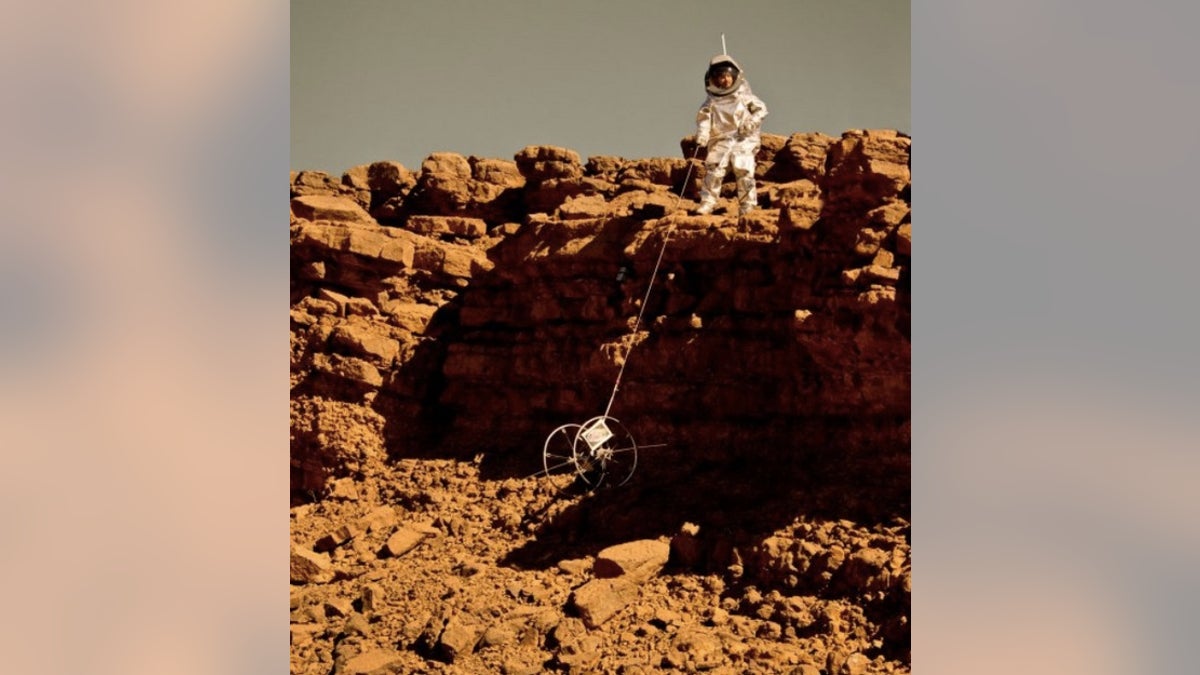
A 'Cliffbot' is lowered over some rocks during a field test in Morocco in 2013. (© OeWF (Katja Zanella-Kux))
A robot that can scale the faces of steep cliffs might one day help explore Mars and find signs of life.
The latest experiments with this "Cliffbot" showed it could help examine places otherwise difficult or impossible for astronauts to safely reach, although further improvements are needed for it to overcome obstacles, according to findings detailed in the journal Astrobiology.
Gullies and canyons with steep cliffs are seen all over Mars. Ancient channels of water may have cut many of these valleys into the rock of the Red Planet, suggesting water may once have flowed on the surface of what is now a dry and dusty world. [The Search for Life on Mars (A Photo Timeline)]
The possibility that water flowed on Mars raises hope that life might once have existed there, or could live there still, perhaps hidden in underground reservoirs. Liquid water is an essential ingredient for life as we know it, and there is life virtually everywhere there is liquid water on Earth.
To see whether the history of Mars includes life, scientists would like to learn more about the planet's past. On Earth, researchers often do this with digs — the older the material is, the deeper it is typically buried. However, digging on Mars is difficult, as doing so requires heavy equipment that is not easy to fly to another planet.
Instead of using robotic or human missions to dig on Mars, researchers want to see if they can take advantage of how naturally occurring gullies and canyons already slice into the Red Planet and expose strata — that is, layers of rock. A robot that can scale the cliffs of these valleys could uncover clues to Martian history. In a sense, the more it would descend, the further back in time it could travel.
Since 2001, the Association Planète Mars, the French chapter of the Mars Society, has experimented with probes capable of being lowered down faces of steep cliffs using cables. The goal is for astronauts to manually operate a Cliff Reconnaissance Vehicle (CRV) or Cliffbot instead of dangling off rock faces themselves, and use cameras and other scientific instruments aboard the robot to analyze difficult-to-reach locations.
The latest series of tests of the Cliffbot were conducted as part of the Austrian Space Forum's MARS2013 project in February 2013. The researchers worked near Erfoud in the Moroccan desert, where the Saharan geology and topography is similar to that of Mars.
Cliffbot was steered by operators as they wore the Aouda.X spacesuit, an outfit designed to simulate what an astronaut in a real spacesuit might experience on Mars. Although the Aouda.X suit is not truly airtight like a real spacesuit, it could simulate many of the major limitations to dexterity and movement that a real suit on Mars would present (for instance, a system that weighs 100 pounds and takes two hours to put on).
The scientists experimented with Cliffbot by descending higher cliffs than ever before (previously the robot was tested on cliffs less than 59 feet high, in areas such as France and Utah). They succeeded in lowering Cliffbot on a cable of up to 150 feet long. These experiments included lowering the robot into a cave mouth on a mud mound, a space that's difficult for an astronaut in a spacesuit to fit through. The researchers added that Mars' lower gravity should make it easier for Cliffbot's operators to lower it to look at items of interest, since on the Cliffbot would weigh roughly 38 percent of what it weighs on Earth.
A wide-view, high-definition camera on Cliffbot helped transmit pictures of numerous fossil seashells embedded in the Moroccan cliffs, suggesting the robot could help astronauts spot any similarly anomalous features on Mars. [7 Biggest Mysteries of Mars]
"The important implication of the Cliffbot experiments is to demonstrate that you can replace a deep drill on Mars with a vehicle going down a slope," said study author Alain Souchier, a mechanical engineer and president of the Association Planète Mars in Vernon, France.
Cliffbot did encounter problems during the tests. In one instance, the operators could not retrieve the robot from a debris-laden slope because a boulder 15.7 inches long became wedged between the right wheel spokes. One way to solve this challenge in the future might be to use solid wheels without spokes.
The scientists placed a camera with a rear-facing mirror on Cliffbot, and the "Hazcam" helped operators see the robot's surroundings to anticipate the hazards it faced. However, when a rock became stuck between Cliffbot's spokes, the operators could not see this problem from the Hazcam or its mirror. The scientists suggested that in the future, they could add cameras directed at its wheels to detect such problems.
"These modifications are technically rather easy to implement," Souchier said.
He added that the Hazcam did help operators understand what the robot was doing when it was hanging over cliffs out of sight.
The researchers noted Cliffbot might in the future carry the same kinds of scientific instruments that are used on other Mars rovers to better explore Mars. For instance, it could bring along a detector of methane, an organic gas whose existence on Mars might suggest the presence of life. Another useful instrument would be the L.I.F.E. laser, which could detect other molecules that are potential signs of life, such as chlorophyll.
Future experiments with Cliffbot are planned in Utah in 2015. A team of aerospace engineering students "expect to bring improvements to the vehicle," Souchier said.
This story was provided by Astrobiology Magazine, a web-based publication sponsored by the NASA astrobiology program.
